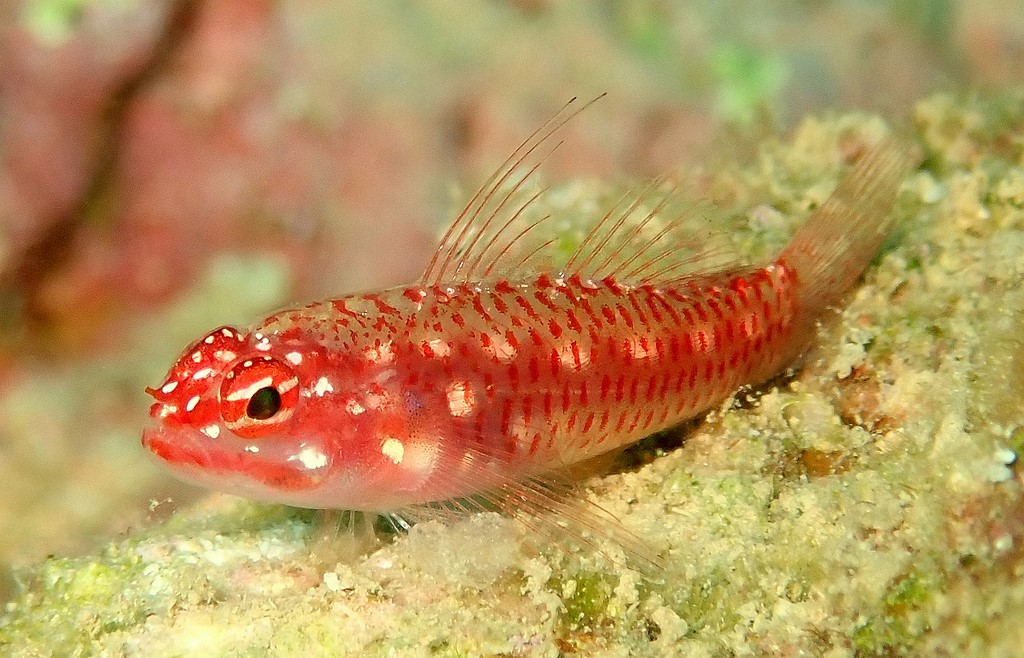EVIOTA PELLUCIDA - (LARSON, 1976)
Picture courtesy of: Alain Daoulas
Actinopterygii (Gigaclass) > Actinopteri (Class) > Teleostei (Subclass) > Gobiiformes (Order) > Gobioidei (Suborder) > Gobiidae (Family) > Gobiinae (Subfamily) > Eviota (Genus)
Gobie pygmée transparent, Transparent dwarfgoby, Kojika isohaze, コジカイソハゼ, 透体矶塘鳢,
Synonyme
Eviota pellucidus (Larson, 1976)
-----------------------
Description
Dorsal spines (total): 7; Dorsal soft rays (total): 8-9 (usually: 8); Anal spine: 1; Anal soft rays: 7; Pectoral fin rays: 15-16 (usually: 16); Pelvic fin rays: I, 4, fourth ray of pelvic fin with 4-6 branches, modally 5; Segments between consecutive branches of the fourth pelvic ray number 3-8, averaging 5.0; Pelvic fin membrane well developed; Branched caudal fin rays: 11; Segmented caudal fin rays: 17; Lateral scale rows 21-22 (usually: 22); Transverse scale rows: 5-6. Head somewhat angular, the snout pointed, the lower jaw slightly projecting; Pectoral fin rays simple; Spinous dorsal fin elongate or filamentous in both sexes; Fifth pelvic fin ray conspicuous, about three-tenths to five-tenths length of fourth fin ray; Breast with scales; Vertebrae: 10 precaudal and 15 caudal, total: 25. Max. length: 2.1 cm SL. Depth range: 3 -30 m.
Color
Dark lines on top of head (if present) in three lines, one behind PITO pore and one on each side near SOT pores; Three dark lines on upper snout; At most a faint dusky spot on upper pectoral-fin base; No dark spot on caudal-fin base below lateral midline.
Etymology
Eviota: from Greek prefix, ev-, eu-, = good or well, very + from Greek letter, iota = smallest letter in the Greek alphabet and often figuratively used to describe anything small or insignificant. Referring to Eviota epiphanes (Jenkins, 1903), which, at 1.0-1.9 cm in length, Jenkins claimed was the “smallest vertebrate that has up to this time been described”.
pellucida: from Latin, per = through + from Latin, lūcidus = clear, bright. Referring to its transparent rose-pink coloration in life (plain yellowish in alcohol).
Original description: Eviota pellucidus Larson, 1976 - Type locality: Double Reef between Uruno and Haputo points, Guam, Mariana Islands, western Pacific, depth 10-26 feet.
Distribution
Western Pacific: eastern Malaya (Malaysia); Gilbert Islands; Marshall Islands; Pohnpei (Micronesia); Mariana Islands; north to Ryukyu Islands (Japan), south to New Caledonia.
Biology
Reported to be associated with the mushroom Heliofungia actiniformis.
Similar species
Eviota prasites (Jordan & Seale, 1906) - Reported from New Caledonia - Link to the species (here).
Actinopterygii (Gigaclass) > Actinopteri (Class) > Teleostei (Subclass) > Gobiiformes (Order) > Gobioidei (Suborder) > Gobiidae (Family) > Gobiinae (Subfamily) > Eviota (Genus)
Gobie pygmée transparent, Transparent dwarfgoby, Kojika isohaze, コジカイソハゼ, 透体矶塘鳢,
Synonyme
Eviota pellucidus (Larson, 1976)
-----------------------
Description
Dorsal spines (total): 7; Dorsal soft rays (total): 8-9 (usually: 8); Anal spine: 1; Anal soft rays: 7; Pectoral fin rays: 15-16 (usually: 16); Pelvic fin rays: I, 4, fourth ray of pelvic fin with 4-6 branches, modally 5; Segments between consecutive branches of the fourth pelvic ray number 3-8, averaging 5.0; Pelvic fin membrane well developed; Branched caudal fin rays: 11; Segmented caudal fin rays: 17; Lateral scale rows 21-22 (usually: 22); Transverse scale rows: 5-6. Head somewhat angular, the snout pointed, the lower jaw slightly projecting; Pectoral fin rays simple; Spinous dorsal fin elongate or filamentous in both sexes; Fifth pelvic fin ray conspicuous, about three-tenths to five-tenths length of fourth fin ray; Breast with scales; Vertebrae: 10 precaudal and 15 caudal, total: 25. Max. length: 2.1 cm SL. Depth range: 3 -30 m.
Color
Dark lines on top of head (if present) in three lines, one behind PITO pore and one on each side near SOT pores; Three dark lines on upper snout; At most a faint dusky spot on upper pectoral-fin base; No dark spot on caudal-fin base below lateral midline.
Etymology
Eviota: from Greek prefix, ev-, eu-, = good or well, very + from Greek letter, iota = smallest letter in the Greek alphabet and often figuratively used to describe anything small or insignificant. Referring to Eviota epiphanes (Jenkins, 1903), which, at 1.0-1.9 cm in length, Jenkins claimed was the “smallest vertebrate that has up to this time been described”.
pellucida: from Latin, per = through + from Latin, lūcidus = clear, bright. Referring to its transparent rose-pink coloration in life (plain yellowish in alcohol).
Original description: Eviota pellucidus Larson, 1976 - Type locality: Double Reef between Uruno and Haputo points, Guam, Mariana Islands, western Pacific, depth 10-26 feet.
Distribution
Western Pacific: eastern Malaya (Malaysia); Gilbert Islands; Marshall Islands; Pohnpei (Micronesia); Mariana Islands; north to Ryukyu Islands (Japan), south to New Caledonia.
Biology
Reported to be associated with the mushroom Heliofungia actiniformis.
Similar species
Eviota prasites (Jordan & Seale, 1906) - Reported from New Caledonia - Link to the species (here).
Eviota shimadai (Greenfield & Randall, 2010) - Reported from Japan (Ogasawara Islands and Ryukyu Islands), Palau and Indonesia (Bali and Raja Ampat).
Eviota spilota (Lachner & Karnella, 1980) - Reported from New Caledonia - Link to the species (here).
Last update: 3, August 2022
Eviota spilota (Lachner & Karnella, 1980) - Reported from New Caledonia - Link to the species (here).
Last update: 3, August 2022
